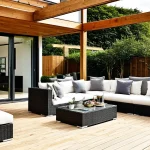Key benefits of sustainable materials in UK home interiors
Sustainable materials deliver significant environmental benefits for UK home interiors by reducing the overall carbon footprint. Compared to conventional options, these materials often require less energy to produce and transport, minimizing their environmental impact. For instance, natural materials like bamboo and wool regenerate quickly, cutting down resource depletion.
In addition to ecological advantages, sustainable materials enhance indoor air quality, which contributes to better health benefits. Many eco-friendly substances emit fewer volatile organic compounds (VOCs), reducing potential allergens and toxins that might affect occupants. This creates a safer, more comfortable living environment promoting well-being.
Topic to read : How Can Innovative Designs Transform UK Home Living Spaces?
Moreover, the durability and longevity of sustainable materials often surpass those of traditional ones. Reclaimed wood and cork, for example, resist wear while maintaining aesthetic appeal over time. This resilience not only extends product lifespan but also lessens waste, reinforcing the eco-conscious cycle in UK homes. Prioritizing sustainable materials thus marries environmental responsibility with practical advantages, making them a smart choice for modern interiors.
Popular sustainable materials for UK homes
Exploring popular eco-friendly materials reveals a strong emphasis on natural and recycled options within UK home interiors. Reclaimed wood stands out as a versatile choice, celebrated for its rustic charm and durability, ideal for flooring and furniture. Bamboo offers a fast-growing, renewable alternative that excels in both strength and aesthetic appeal. Cork, another sustainable material, is prized for its insulation properties and comfortable underfoot feel.
In the same genre : How can you create a seamless indoor-outdoor living experience in your UK home?
Soft furnishings frequently incorporate UK-sourced wool, hemp, and organic cotton. Wool provides natural insulation and moisture regulation, enhancing indoor comfort and supporting local agriculture. Hemp is highly durable and requires minimal pesticides, making it an environmentally responsible choice that fits well in textiles and upholstery. Organic cotton, grown without harmful chemicals, promotes healthier living spaces while maintaining softness.
Recycled materials such as glass, metal, and plastic are gaining traction in interior features. Recycling reduces waste and lessens the need for virgin resources, directly lowering the carbon footprint. For example, recycled glass can be crafted into stunning countertops or decorative panels, combining beauty with sustainability. Together, these materials embody how UK residents can embrace stylish yet responsible interior design choices.
Practical applications of sustainable materials in UK interior design
Sustainable materials find diverse practical uses in UK interior design, transforming homes with eco-friendly solutions that balance style and function. Flooring is a prime example; reclaimed wood and cork offer durable, natural surfaces that enhance warmth and texture. Bamboo’s adaptability suits cabinetry and worktops, providing strength with a light environmental footprint.
Wall treatments using sustainable options like clay plaster or low-VOC eco-friendly paint improve indoor air quality while adding unique finishes. These choices avoid harmful chemicals common in traditional products, supporting respiratory health. Furniture crafted from recycled metals or sustainably harvested woods combines longevity with aesthetic appeal, ensuring pieces remain functional and elegant over time.
Incorporating sustainable materials into built-in storage and shelves optimises space without compromising environmental values. Decorative accents such as hemp textiles and organic cotton cushions add softness and comfort, completing interiors with a conscious touch.
By embracing practical applications throughout the home, UK residents benefit from interiors that are not only visually pleasing but also promote well-being and reduce environmental impact. Integrating these sustainable materials in everyday design brings a sense of responsibility coupled with modern elegance.






